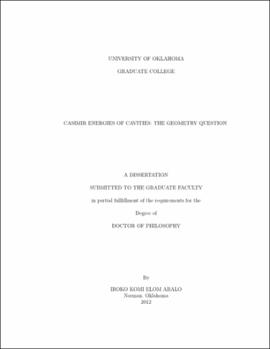| dc.contributor.advisor | Milton, Kimball | |
| dc.creator | Abalo, Elom | |
| dc.date.accessioned | 2019-04-27T21:38:26Z | |
| dc.date.available | 2019-04-27T21:38:26Z | |
| dc.date.issued | 2012 | |
| dc.identifier | 9939946002042 | |
| dc.identifier.uri | https://hdl.handle.net/11244/319236 | |
| dc.description.abstract | The question of how the Casimir effect relates to a system's geometry is of fundamental interest. In this thesis, we present new results for interior Casimir self-energies of various integrable geometries and show interesting systematic relations between these energies. In particular, we consider prisms with triangular cross sections (equilateral, hemiequilateral, and right isosceles triangles), triangular polygons of the same cross sections, and three tetrahedra. The triangular prisms are of infinite or finite lengths. | |
| dc.description.abstract | % These geometries are integrable and unique in the sense that the Laplacian eigenvalues may be found using the method of images. | |
| dc.description.abstract | We obtain interior Casimir energies for these cavities subject to Dirichlet and Neumann boundary conditions. In addition to these boundary conditions, we also obtain electromagnetic Casimir energies for the infinite prisms. | |
| dc.description.abstract | These energies are regularized using various consistent methods, one of which is regularization by point-splitting. Summing these modes explicitly using a cylinder kernel formulation, we show that the correct Weyl divergences are obtained. We also give closed-form results for the infinite triangular prisms. In order to understand the geometry dependence of these energies, we rederive well-known results for rectangular parallelepipeds (including the cube) and infinite rectangular prisms. | |
| dc.description.abstract | The analysis of these self-energies yields intriguing results. By plotting the scaled energies against the appropriately chosen isoperimetric or isoareal quotients, we observe interesting patterns, which hint towards a systematic functional dependence. In addition to the calculation of new Casimir energies, this constitutes a significant contribution to the theoretical understanding of self-energies and has interesting implications. | |
| dc.format.extent | 100 pages | |
| dc.format.medium | application.pdf | |
| dc.language | en_US | |
| dc.relation.requires | Adobe Acrobat Reader | |
| dc.subject | Casimir effect | |
| dc.title | Casimir energies of cavities: The geometry question | |
| dc.type | text | |
| dc.type | document | |
| dc.thesis.degree | Ph.D. | |
| ou.group | College of Arts and Sciences::Homer L. Dodge Department of Physics and Astronomy | |
